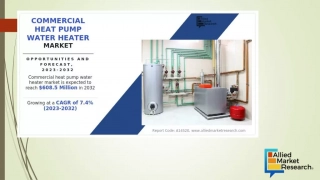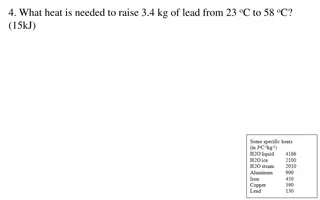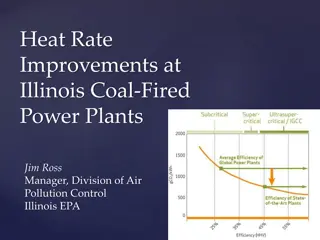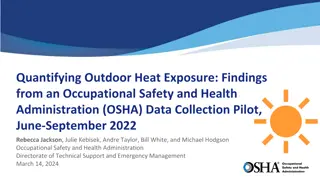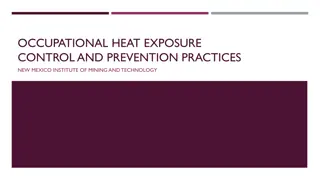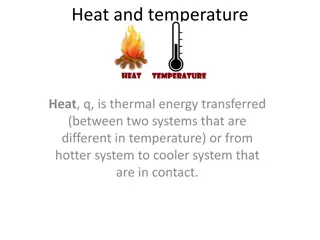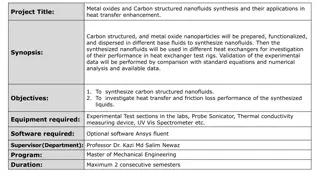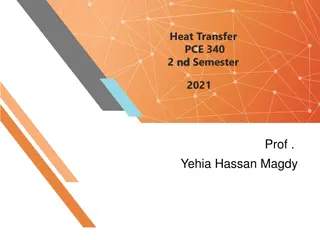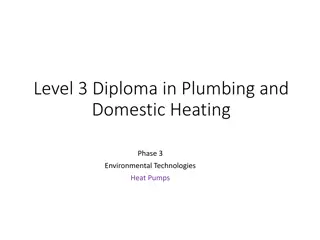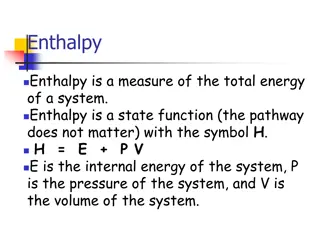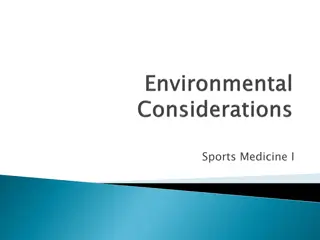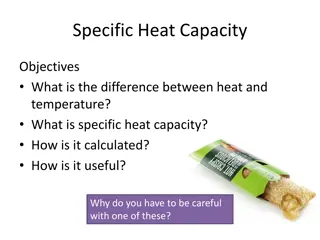
Improving Comfort in Non-Air-Conditioned School Facilities: Challenges and Solutions
Discover the challenges faced by schools with inadequate air conditioning, the effects of high temperatures on learning environments, and the efforts to enhance comfort through various cost-effective solutions. Explore the proposed options and costs to increase comfort in non-air-conditioned buildings amidst heat concerns.
Download Presentation

Please find below an Image/Link to download the presentation.
The content on the website is provided AS IS for your information and personal use only. It may not be sold, licensed, or shared on other websites without obtaining consent from the author. If you encounter any issues during the download, it is possible that the publisher has removed the file from their server.
You are allowed to download the files provided on this website for personal or commercial use, subject to the condition that they are used lawfully. All files are the property of their respective owners.
The content on the website is provided AS IS for your information and personal use only. It may not be sold, licensed, or shared on other websites without obtaining consent from the author.
E N D
Presentation Transcript
88 school facilities within DPS are either non-air conditioned or have only partial air-conditioning. (55 ES, 14 HS, 10 MS, 9 Other) In the last year, the metro area experienced above normal temperatures for the region, temperatures that reportedly had not been seen in more than 50 years. During this period, temperatures in some non-air conditioned classrooms rose to above 95 degrees during the school day. Facility Management staff implemented procedures to lessen the heat impact by training building occupants, ensuring ventilation system functionality, fan placement, duct cleaning where needed, etc. Strong concern and frustration has been understandably expressed at student and staff discomfort, noting that learning opportunities suffer in these circumstances. In January of 2012, the Superintendent assembled a calendar committee to review the 2012-13 school calendar & make recommendations a change to the start of the school year in an effort to mitigate some of the high heat concerns. A survey was conducted with significant response from parents. As a result, the next school year start date was moved back to August 27th. (See attached 2012-2013 Calendar Development Background) Facility Management staff has since taken a number of steps to improve the current situation, and to recommend potential solutions for dealing with high heat periods. Despite ongoing efforts to improve comfort during high-heat periods, we will likely continue to experience high temperatures within non-air conditioned buildings during high temperature periods unless all buildings are upgraded with air-conditioning or some form of cooling solution. The estimated costs to air-condition all current facilities is approximately $350 million. A request was made by the Board of Education to evaluate school closing options during excessive heat circumstances.
Completed analysis of historical temperatures throughout the year as input to the calendar committee in making recommendations on changing the start date. Last year was an extremely hot summer, with August being the hottest on record. Conducted a detailed evaluation of 10 non-air-conditioned facilities to: Assess issues/improvement opportunities with current systems within the schools Provide options/solutions for improving in-building comfort when outside temperatures reach excessive levels for an extended period of time. The output is a set of 3 options, at varying levels of cost, to improve comfort. These options will be presented to the Citizen s Planning Advisory Committee for review and potential inclusion in a 2012 Capital Bond program. Collaborated with experts, and evaluated various existing/emerging technologies that could improve comfort at a cost lower than traditional air conditioning. While some options are being developed that show promise, no single low-cost silver bullet was found Contacted other school districts to better understand any policies/procedures being used for non-air- conditioned schools during times of excessive temperature. Results were diverse, with no districts identified that had implemented policies for school closure during these times. Many districts defined high-heat situations (generally using the heat index see Appendix), documented the risks, and developed and communicated procedures for building occupants to follow to improve comfort during those situations (included ensuring sufficient availability of water, modified dress codes, use of fans, ) Developed a draft policy for potential adoption by the Superintendent and/or BoE. Developed new procedures for school building occupants and Facility Management staff to follow to improve our collective response to high-heat conditions in non-AC facilities. Began implementation of readiness plans for all non-AC schools in advance of the hotter months ahead.
The remainder of this presentation will focus on: What are the options and costs to increase the comfort in non-AC buildings? Potential policy changes related to school closure due to heat: Should we consider closing schools during periods of excessive temperatures? If so, Under what conditions would closure be considered? Who would make this decision? What would be the impact of implementing this change? What process improvements/procedural changes are planned to be implemented to prepare for the upcoming high temperature months?
Options for Improving Comfort in non- AC Schools
Conducted a study using a sampling of non-AC schools across the district: 10 Schools were selected that were representative of construction type, age, and use: West High School Thomas Jefferson High School Morey Middle School Hallet Fundamental Academy Stedman Elementary Brown International Academy Mitchell Building Beach Court George Washington Godsman
Morey Middle School: Address: 840 14th Ave., Denver, CO Constructed: 1921 Gross ft : 130,669ft Grades: 6-8 Students: 813 Findings: Phase I Temporary Fan Program / Operable Window Program / Shading Programs / Controls Modification / Deferred Site Corrections o Installation: $77,400 o O&M (per year): $1,500 o Electrical Use (per year) ~$1,100 Phase II Phase I Site Corrections / New Ceiling for Airflow / New Exhaust & Relief Fans / Phase I Window & Shade Plan / New Ductwork / Individual Space Exhaust Fans / 8 Evaporative Units / Plumbing Modifications / Deferred Site Corrections o Installation: $194,000 o O&M (per year): $8,750 $17,500 o Electrical Use (per year) ~$2,800 Phase III Phase I Site Corrections / Plumbing Modifications / New Water Chiller Plant / Electrical Upgrades / Replace Steam System with Hot Water System / New Water Mains / Install New Air System / Replace Ancillary Steam Equipment / New DDC Controls / Phase I Window & Shade Plan / Deferred Site Corrections o Installation: $2,920,000 (DPS All Inclusive Cost Excluding Inflation $4,478,000) o O&M (per year): $13,350 - $26,700 o Electrical Use (per year) ~$6,000
Phase 1 Approach: Temporary Measures (immediate implementation) : This includes the use of portable fans, operable window programs, and exhaust fans to provide temporary thermal comfort. Estimated Cost for Phase I A/C Solution at 88sites: ~$11M Phase 2 Approach: Intermediate Measures: This approach shall include measures to provide thermal comfort to the facility for a short term program. These measures may include the installation of whole building supply and/or exhaust fans, implementation of evaporative cooling for existing air handling systems, operable window programs, and similar measures to provide thermal comfort for the facility. Estimated Cost for Phase II A/C Solution at 88sites: ~$24.5M (~5-8yr solution) Phase 3 Approach: Permanent Cooling Measures: This approach of the project includes measures to provide permanent cooling to the facility in the form of Air Conditioning. The systems utilized may include chilled water, direct expansion, or similar methods to provide cooling and thermal comfort. This portion of the project shall be limited to the general documentation required as part of a future bond scope of work. Estimated Cost for Phase III A/C Solution at 88sites: ~$350M (~20yr solution) Final solution may include combinations of Phase 1-3 *Cost does not include annual O&M, deferred maintenance, or additional utility cost
Phase 1 Approach: Temporary Measures Initial Installation: ~$11mil O&M Cost (per year): ~$150,000 - $300,000 Electrical Use (per year): ~$140,000 - $225,000 Phase 2 Approach: Intermediate Measures Initial Installation: ~$24.5M (5-8yr solution) O&M Cost (per year): ~$1.25mil - $2.5mil Electrical Use (per year): ~$275,000 - $500,000 Phase 3 Approach: Full air-conditioning Initial Installation: ~$350M (20yr solution) O&M Cost (per year): ~$1.1mil - 2.2mil Electrical Use (per year): ~$662,000 - $1mil **Cost conservative based on assumption of sustainable management practices
Electric Cost of A/C in non-A/C Schools Lean number of days/year of A/C operation (Aggressive energy conservation): Annual Electric Cost @ 37 days/year = $377,120 More realistic number of days/year of A/C operation: Annual Electric Cost @ 65 days/year = $662,205
Potential policy changes related to school closure due to heat
During extreme heat outdoors, building temperatures indoors may reach excessive temperatures that are uncomfortable for classroom instruction regardless of the mitigation strategies that have been implemented. In the event of excessive heat, it may be necessary for non-air-conditioned facilities to be closed for the day or closed for part of the day. Designated instructional leadership can decide to close a school based upon excessive temperatures within the building. The following may be used as a guide or as options: Parents will be given the option to pick up their child with an excused absence for the day. The school will remain is session. Partial closure: Afternoon temperatures in the building reach or are expected to reach greater than 96 degrees Full day closure: Early determination that full day building temperatures (after remediation measures have been taken) will reach above 96 degrees and will prevent the opening of the building for the next day. The school district's intent is to have students attend school all day, but the safety and well- being of students and staff is paramount. If at all possible, a decision will be made in the evening prior to any heat-related closing. Notification to school employees, students, families and appropriate news media will be made before 6:00 p.m. on the day preceding the closure. The decision to close will be based upon the determination of whether the environment is deemed safe based on the temperatures within the classrooms and after steps has been taken to alleviate the excessive heat conditions.
The decision to close will be based upon the determination of whether the environment is deemed safe based on the temperatures within the classrooms and after steps has been taken to alleviate the excessive heat conditions. To determine the level of response actions and consideration for closure, the attached heat index chart will be used for reference (Appendix A). The District will NOT make decisions to close all schools (or all schools without A/C) due to heat conditions. The primary reasons for this are: Only half of schools do not have A/C; Air-conditioned schools can function comfortably in high external heat conditions Amongst schools without A/C, the temperatures can vary greatly building by building (and within buildings). Some schools may be somewhat uncomfortable, while others may be extremely uncomfortable. Individual schools have and can develop different mechanisms for coping with heat.
Facility Management Sustainability Office will monitor weather forecast to determine if excessive temperatures are expected and provide appropriate communication to schools and other internal stakeholders. Facilities Management will evaluate actual conditions within a school based on the latest weather forecast (in relation to building conditions prior to the school day), and advise instructional leadership by [4:00 p.m.] on the preceding day of the expected building conditions. Facility Management has issued digital thermometers to every Facility Manager within the District that will be used to verify actual temperatures within the classrooms. Additional response determination will be based upon overall conditions within the building. The Facility Manager will record data and forward to Principal, Sustainability Director, and Executive Director of Facilities. Facilities Management will carry out the recommended actions for each individual school [as shown in the [Facilities Actions section of this document] including: Earlier work shifts for Facilities personnel to open up the building to move cooler air through the facility for several hours prior to start of classes in the morning. Placing fans or other cooling equipment in designated spaces to improve comfort in the buildings. Implementing other building-specific actions designed to increase comfort for students and staff. Instructional leadership (the school principal and Instructional Superintendent) will make a recommendation to their supervisor, either the Assistant Superintendent for Secondary Education, the Assistant Superintendent for Elementary Education or the Chief of Innovation & Reform (OSRI), on whether classes should be cancelled or the school schedule otherwise modified for the following day:
Managing Excessive Heat in DPS Buildings Options for Improving the Environment Early Response Actions School Based Analysis and Study Response Approach Level 1, 2 , 3 or Combo Policy/Procedure Heat day closure procedures Closure for Heat Yes/No? When? Communication Who to Notify? Precautions/Advisory on Heat Steps to Mitigate heat Best Practices Ten Tips Operational Procedures School Responsibility Nursing Services Transportation Communication Plan
Process Improvements/Procedural Changes to be Implemented to Prepare for Upcoming Warm Weather Months
Steps include: Early communication with all buildings prior to the heat season to ensure knowledge of proper procedures and how to alleviate the heat. Complete building assessment prior to school year to ensure all systems are functioning at optimum capacity and as designed. Consideration of purchasing large portable units for future emergency use only (evaporative coolers). These will not cool an entire school, but can be set up in a main hallway directly connected to an outside door (source of fresh air). There is storage, operational and maintenance considerations that must be taken into account. Development of operational procedures (similar to snow removal strategy) to ensure maximum air flow overnight, operating equipment through controls, and keeping the building secure if windows are to be left open. Standard operational procedure communication distribution to all Principals and FM s prior to the start/end of school.
Heat Mitigation in Buildings Recommended Best Practices to Minimize Excessive Heat in Schools Please support energy conservation to gain savings and limit heat buildup in buildings with the following: All Users Be a role model by being a leader in energy conservation. Instruct others about your school s commitment to saving energy and mitigate heat in buildings. Be alert for energy waste (typically high heat buildup equipment) at all times: lights, computers and heating systems left on excessively not only waste energy but create unnecessary heat in the buildings. Use computers only when necessary, turn off each evening and turn monitors off whenever not using. Facility Managers Turn on corridor lights at the latest possible time before students arrive each morning and only as needed. Turn lights off as early as possible after students leave. Make sure boilers and heating circulation pumps are off during warm months Work with fewer lights turned on when possible, especially areas with ample daylight such as corridors, entryways and common areas. Encourage smart use of window blinds to keep heat from entering building. Open up building windows and doors whenever possible and safe to allow early morning cool air ventilation. Make suggestions to maintenance staff and administration to improve energy and thermal efficiency. Report heating and/or air conditioning problems promptly Teachers Turn off or minimize lighting whenever possible, especially when out of the classroom. Close doors and windows whenever outside temperature exceeds inside temperature Use window blinds smartly to minimize heat intrusion. Close blinds at night and open windows early in the morning to capture cool air movement. Turn off all smart and promethean boards whenever not in use and especially at the end of each day. Minimize or eliminate the use in classrooms of compact refrigerators, microwave and toaster ovens and coffee brewers. IBAS and HVAC Maintenance Ensure proper operation and set points of all HVAC equipment. Optimize HVAC controls to purge buildings whenever possible with cool early morning air. Minimize use and operation of any unnecessary equipment Kitchen Managers Minimize daily run times of all heat producing equipment (steam tables, ovens, etc.) Follow shutdown and conservation guidelines of all refrigeration equipment. Report any malfunctioning equipment promptly (be especially aware of refrigeration equipment with dirty coils).
The following actions were typical across all non-air conditioned schools August 15 Sept 2nd: Minimum shift 9 hours, 6 days per week. Some techs working 16 hrs day Box fans delivered to hottest schools and placed in ECE areas first Opening of windows in the early AM to draw in cooler air and adjustment of FM shift to come in earlier to open the windows Operation of ventilation equipment overnight to draw in cooler air Recommendation to shut windows before it gets too hot later in the day Ventilation equip. turned off before it gets too hot and draws in hotter air Recommendation to close window shades and blinds during full sun periods Education of Principals, FM's and staff on extreme heat building operation Building system operation checked for proper operation by operations and/or Maintenance staff Ventilation equipment was repaired where parts/supplies were readily available during that period (work tasks were created for work not immediately completed) Electrical system load capacity was reviewed, and recommendations made, for schools that planned on bringing in their own portable AC units
Denver Historic Peak Day Temperatures 5 Year Average (August 15 September 15) 2007-2011 Denver Weather 5 Year Avg. - Peak Temperatures 100 90 80 70 Denver Weather 5 Year Avg. - Peak Temperatures 60 50 40 30 20 10 0 1-Sep 2-Sep 3-Sep 4-Sep 5-Sep 6-Sep 7-Sep 8-Sep 9-Sep 10-Sep 11-Sep 12-Sep 13-Sep 14-Sep 15-Aug 16-Aug 17-Aug 18-Aug 19-Aug 20-Aug 21-Aug 22-Aug 23-Aug 24-Aug 25-Aug 26-Aug 27-Aug 28-Aug 29-Aug 30-Aug 31-Aug
Denver Weather Data Denver Daily Maximum Temperatures 2011 Month # of Days over 85 Degrees # of Days over 90 Degrees June 15 7 July 29 20 August 30 22 September 8 1
Denver High Temperature Data 95 1995 85 1996 1997 75 1998 1999 65 2000 55 2001 Average 45 Trend 35
Denver Low Temperature Data 80 70 1995 60 1996 1997 50 1998 40 1999 2000 30 2001 20 Average 2002 10 Trend 0 -10 -20 -30
Historical Peak Temperatures Denver Historical Peak Temperatures June August 2007 2008 2009 2010 2011 2007 2008 2009 2010 2011 1 67 85 73 84 82 16 88 58 79 83 90 2 73 89 54 79 91 17 91 69 74 88 94 3 75 83 67 84 75 18 91 75 81 96 98 4 79 69 71 93 78 19 93 83 82 86 87 5 84 60 78 85 90 20 95 89 82 88 89 6 84 79 79 92 90 21 97 90 86 94 94 7 69 77 69 94 86 22 86 78 96 97 97 8 75 73 69 80 79 23 74 84 98 86 98 9 84 78 75 86 67 24 82 86 86 81 98 10 90 93 73 82 75 25 88 90 77 90 99 11 92 71 68 77 81 26 95 90 84 95 92 12 70 73 70 52 86 27 89 86 88 95 96 13 76 80 78 57 85 28 85 75 85 93 96 14 81 90 74 67 82 29 82 85 82 93 89 15 88 91 74 79 86 30 89 89 71 87 93 # Days > 90 1 2 0 3 1 31 91 91 89 81 98 # Days > 90 7 1 2 7 12
2012 School Year Calendar Heat Index List of non-AC Schools Weather Chart data FAQ

